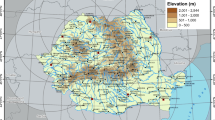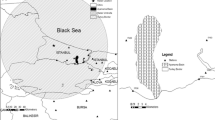Abstract
Two methods estimating areal precipitation for selected river basins in the Czech Republic are compared. The methods use radar precipitation (the radar-derived precipitation estimate based on column maximum reflectivity) and data from 81 on-line rain gauges routinely provided by the Czech Hydrometeorological Institute. Data from a dense network of climatological rain gauges (the average inter-station distance is approximately 8 km), the measurements of which are not available in real time, are utilized for the verification. The mean areal precipitation, which is used as the ground truth, is obtained by the weighted interpolation of the dense rain gauge network. The accuracy of the methods is evaluated by the root-mean-square-error.
The first, pixel-related method merges radar precipitation with rain gauge data to obtain adjusted pixel values. The adjusting procedure combines radar and gauge values in one variable that is interpolated into all radar pixels. The adjusted pixel precipitation is calculated from radar precipitation and from the value of the combined variable. The areal estimates are determined by adding the corresponding pixel values. The second method applies a linear regression model to describe the relationship between the areal precipitation (dependent variable) and its estimates, which are determined from (i) non-adjusted radar precipitation and (ii) on-line rain gauge measurements interpolated into pixels. Classical linear regression, ridge regression and robust regression models are tested.
Both the methods decrease the average areal error in comparison with the reference method, which uses the on-line rain gauge data only. The decrease is about 10% and 15% for the pixel-related and regression methods, respectively. When the estimates of the pixel-related method are included as predictors into the regression method then the improvement of accuracy is almost 25%.
Similar content being viewed by others
References
Austin P.M., 1987. Relation between measured radar reflectivity and surface rainfall. Mon. Wea. Rev., 115, 1053-1070.
Bhargava M. and Danard M., 1994. Application of optimum interpolation to the analysis of precipitation in complex terrain. J. Appl. Meteor., 33, 508-518.
Ciach G.J. and Krajewski W.F., 1999. Radar-rain gauge comparisons under observational uncertainties. J. Appl. Meteor., 38, 1519-1525.
Collier C.G., 1996. Applications of Weather Radar Systems. Praxis Publishing Ltd., Chichester, 390 pp.
Dodge Y. and Jure?ková J., 2000. Adaptive Linear Regression. Springer-Verlag, New York, 177 pp.
Fišer O., Schonhuber M. and Pešice P., 2002. First results of DSD measurement by videodistrometer in the Czech Republic in 1998?1999. Stud. Geophys. Geod., 46, 485-505.
Fulton R.A., Breidenbach J.R., Seo D.J. and Miller D.A., 1998. The WSR-88D rainfall algorithm. Wea. Forecasting, 13, 377-395.
Joss J. and Waldvogel A., 1990. Precipitation measurements and hydrology. In: D. Atlas (Ed.), Radar in Meteorology, Amer. Meteor. Society, Boston, MA, 577-606.
Gabella M. and Amitai E., 2000. Radar rainfall estimates in an alpine environment using different gage adjustment techniques. Phys. Chem. Earth (B), 25, 927-931.
Gibson M., 2000. Comparative study of several gauge adjustment schemes. Phys. Chem. Earth (B), 25, 921-926.
Germann U. and Joss J., 2001. Variograms of radar reflectivity to describe the spatial continuity of Alpine precipitation. J. Appl. Meteor., 40, 1042-1059.
Groisman P.Y. and Legates D.R., 1994. The Accuracy of United States Precipitation Data. Bull. Am. Met. Soc., 75, 215-227.
Harrison D.L., Driscoll S.J. and Kitchen M., 2000. Improving precipitation estimates from weather radar using quality control and correction techniques. Meteorol. Appl., 6, 135-144.
Havránek P. and Krá?mar J., 1996. New weather radar station in central Moravia. Czech Meteorological Bulletin, 49, 81-84.
Huffman G., 1997. Estimates of root-mean-square random error for finite samples of estimated precipitation. J. Appl. Meteor., 40, 1042-1059.
Krá?mar J., Joss J., Novák P., Havránek P. and Šálek M., 1998. First steps towards quantitative usage of data from Czech weather radar network. In: COST75 Advanced Weather Radar Systems. International seminar, Locarno, Switzerland, 23?27 March 1998, 91-101. Office of Official Publications of the European Communities, Luxembourg.
Michelson D.B. and Koistinen J., 2000. Gauge-radar network adjustment for the Baltic Sea experiment. Phys. Chem. Earth (B), 25, 915-920.
?ezá?ová D., Sokol Z., Krá?mar J. and Novák P., 2001. Statistical adjustment of radar-based daily precipitation to ground data from the Czech territory. In: Proceedings of the 30 th International Conf. on Radar Meteorology, Munich, Germany, 19?24 July 2001. Amer. Meteorol. Soc., 570-572.
Seed A.W., Nicol J., Austin G.L., Stow C.D. and Bradley S.G., 1996. The impact of radar and raingauge sampling errors when calibrating a weather radar. Meteor. Appl., 3, 43-52.
Seo D.J., 1998. Real-time estimation of rainfall fields using rain gauge data under fractional coverage conditions. J. Hydrol., 208, 25-36.
Seo D.J., Krajewski W.F., Azimi-Zonooz A. and Bowles D.S., 1990a. Stochastic interpolation of rainfall data from rain gauge and radar using cokriging. 1. design of experiments. Water Resour. Res., 26, 915-924.
Seo D.J., Krajewski W.F., Azimi?Zonooz A. and Bowles D.S., 1990b. Stochastic interpolation of rainfall data from rain gauge and radar using cokriging. 2. results. Water Resour. Res., 26, 915-924.
Sokol Z. and ?ezá?ová D., 2001. Application of statistical regression to the statistical correction of radar?based daily precipitation. Czech Meteorological Bulletin, 54, 46-56 (in Czech with English summary).
Šálek M., 2000. The radar and rain gauge merged precipitation estimate of daily rainfall-First results in the Czech Republic. Phys. Chem. Earth (B), 25, 977-979.
Author information
Authors and Affiliations
Rights and permissions
About this article
Cite this article
Sokol, Z. The Use of Radar and Gauge Measurements to Estimate Areal Precipitation for Several Czech River Basins. Studia Geophysica et Geodaetica 47, 587–604 (2003). https://doi.org/10.1023/A:1024715702575
Published:
Issue Date:
DOI: https://doi.org/10.1023/A:1024715702575




